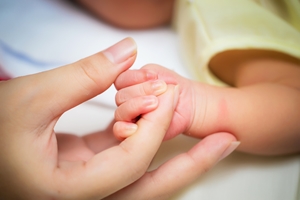As a new parent, you may be a little paranoid about keeping baby safe. You probably have a million questions running through your mind such as, "Is my baby safe in his or her bedroom?"
It can be worrisome when baby sleeps in his or her own room for the first time, or really, when baby does anything for the first time. It's because of this that many parents choose to co-sleep with their little one for the first several months of his or her life, and that's OK.
Tips for keeping baby safe
If you're in search of tips on how to keep baby safe, try these:
The crib
When it comes to baby's crib, ensuring safety is your No. 1 priority. Crib slats should be 2 3/8 inches apart or less so your little bundle of joy can't squeeze his or her head or other body parts through and get stuck. You should also ensure that the space between the mattress and the sides of the crib is less than the width of two fingers. You'll want to make sure that there aren't any curtains or drapery near the crib so baby can't grab on and suffocate. You should never put pillows, big floppy toys or plastic sheeting in the crib. Stay away from crib bumpers, because they actually put baby at more risk than you might think. Baby can roll and get stuck with his or her face against the bumper, leading to suffocation. While there are breathable bumpers, you should avoid them altogether.
Sleeping
Whether baby sleeps in his or her crib or in a bassinet next to your bed, it's common for parents to worry about sleep positioning because of Sudden Infant Death Syndrome (SIDS). Pediatricians and medical professionals continually remind you that baby should be placed on his or her back to sleep, never belly down. When your little one is on his or her belly, they aren't strong enough to move their heads should they get stuck face down in the mattress. Until he or she can lift their head on their own and roll over without your help, you'll want to keep them on their back.
Car seat
You probably already know, but baby should be kept in the backseat in a rear-facing infant car seat in the middle of the car. Although many of today's car seats are exceptionally safe for little one, you can't always control whether or not you get into a car accident, so you want to keep baby as safe as possible. Your rear-facing seat will prevent the front seats from being pushed back onto baby in the event of a collision. While it can be stressful worrying about baby when you can't see him or her, this is the safest way for your little one to ride in the car.
Bathing
You should always keep an eye on the temperature of your baby's bath water. Whether your precious one is in the sink or a tub, the water should be comfortably warm. You can test it by dipping your elbow in the water. Keep in mind that baby tubs are not safety devices, so you should always keep an eye on your baby while he or she is bathing. You should never, ever, not once, leave the room while your baby is taking a bath. This is the same rule about leaving a toddler in the pool if only for "a moment." It's just too easy to get distracted and end in tragedy.
Stay smoke-free
Although people know how bad smoking is for themselves and the people around them, they choose to do it anyway. In the case of your baby's health, make sure that those around your little one are smoke-free, or not smoking around him or her. Don't allow visitors to smoke in your home or car. If they must smoke while at your home, tell them to go outside, wash their hands and face and change their clothes before picking up and holding your baby.
How are you keeping your baby safe? Share in the comments below!
